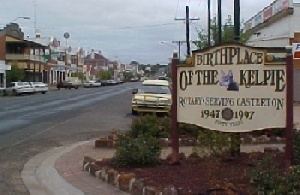Population 1,425 (2011 census) Postcode(s) 3311 Postal code 3311 | Established 1846 Elevation 73 m Local time Monday 6:48 PM | |
 | ||
Location 359 km (223 mi) from Melbourne103 km (64 mi) from Portland69 km (43 mi) from Mount Gambier Weather 22°C, Wind SE at 26 km/h, 59% Humidity | ||
Casterton /ˈkɑːstətən, ˈkæs-/ is a town in Victoria, Australia, located on the Glenelg Highway, 42 kilometres east of the South Australian border, in the Shire of Glenelg. The Glenelg River passes through the town. Casterton is named after the village of Casterton in south-east Cumbria in England.
Contents
- Map of Casterton VIC 3311 Australia
- History
- Timeline
- The kelpie
- The Fleur de Lys
- Community
- Notable residents
- References
Map of Casterton VIC 3311, Australia
History
Prior to white settlement, Aboriginal people of the Konongwootong Gundidj clan lived in the local area. The first white explorers to pass through the area were the expedition led by Major Thomas Mitchell in 1836 who spoke enthusiastically of the landscape's green hills, soft soils and flowery plains, describing it as ideal for farming and settlement, naming it Australia Felix. The first white settlers in the area were the Henty brothers who had landed in Portland, Victoria in 1834 and who claimed 28,000 hectares between what are now the towns of Casterton and Coleraine. 'Warrock' Station, a sheep farming settlement, was established in 1841, 26 km north of what would be Casterton.
The township of Casterton began on the crossing site of the Glenelg River, the location having been surveyed in 1840, and the first pub, the Glenelg Inn, was established in 1846 with a post-office opening the following year. The early history of the region was marred by violent clashes between settlers and Indigenous people, including multiple murders of Aboriginals that took place near Casterton in the late 1830s and early 1840s.
In 1891, a large number of Casterton women signed the Women's Suffrage Petition to be tabled in the Victorian Parliament to grant women the right to vote (which was not allowed until 1908). By the 1890s, increasing soil erosion saw wheat-farming around Casterton begin to decline and it was largely replaced by meat, wool & dairy farming. Casterton's population expanded in the early 20th century, especially in the 1920s with the arrival of large numbers of soldier-settler farmers and during the post-war era in the 1950s.
The Rail line to Casterton was closed in 1977. The town's population began to decline in the 1990s which was consistent with the statewide trend of decreasing populations in many agricultural areas and the ageing of the local population. The 2011 census indicated the average age of Casterton's population was 52.
Timeline
The kelpie
Casterton lays claim to be the birthplace of the breed of working dog known as the kelpie, a Scottish term meaning 'Water Sprite' and a name given to a black and tan bitch British working collie owned by Scotsman George Patterson, a farmer who lived north of Casterton in the 1870s. Patterson exchanged 'Kelpie' for a horse and the dog's new owner, a drover named Jack Gleeson, took her to Ardlethan, New South Wales where she mated with a black male Rutherford Sheepdog named 'Moss', producing several litters. Kelpie later mated with another male named 'Caesar', producing a female pup named 'King's Kelpie' which grew to become a champion sheepdog.
The breed was further developed and refined during the next few decades. Ardlethan also lays claim to be the birthplace of the breed.
In 1997, a working dog auction was held in Casterton, an annual event which grew to become the Casterton Kelpie Festival in 2001. The auction and festival event is now held each June in Casterton
To mark Casterton's 150th anniversary celebrations in 1996, a bronze sculpture of a kelpie by artist Peter Corlett was unveiled in front of Casterton's Town Hall.
The Fleur de Lys
A large version of the Fleur de Lys, used as the emblem of the Scouts, is carved into Toorak Hill, a steep hill overlooking the eastern end of Casterton's main thoroughfare. The design has a circumference of 91 metres. In 1935, the Boy-Scouts and Cubs, in honour of the Silver Jubilee Celebrations of King George V, carved a large-scale version of the words 'The King' into the hill, each letter some 20 feet long. Encouraged by the success of this, the Scouts, to celebrate the 1941 opening of the town's new Scout-hall, carved the Fleur de Lys emblem into the hill and lit it up at night with the aid of a series of tins filled with oil-soaked rags which were set alight. Years later, the design was lit by electric strip lighting and is illuminated on most evenings throughout the year.
Community
The town has a Community Centre, a weekly local newspaper and hosts many activities throughout the year.
The town has an Australian rules football team competing in the Western Border Football League. Casterton Football Club, originally formed in 1875, won the Western District League Premiership 12 times between 1892 and 1963 and has won the Western Border League Premiership twice, in 1969 and 1990.
The Casterton Racing Club schedules around four horse race meetings a year including the Casterton Cup meeting in May or June.
Golfers play at the Casterton Golf Club on Penola Road.
The town has a public outdoor swimming pool, a hospital, a secondary college and state & Catholic primary schools.
Notable residents
Notable residents of Casterton include:
